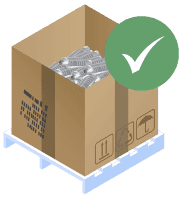Catalytic converter 101
What Are Catalytic Converters and How Are They Recycled?

Whether you’re a seasoned recycler or you’ve just been introduced to your new toll-refiner, we understand that the converter recycling process presents a minefield of questions. Why are they recycled? What are the stages in converter recycling? When do I get paid?
To make sure you have all the answers you need, we created a converter recycling guide to help you understand every step of the process. By the end of this guide, you’ll have the right information and the confidence to team up with a processor who will help you get the most from your material.
Why Do We Use Catalytic Converters and How Do They Function?
In the 1970s, the US Environmental Protection Agency (EPA) began regulating emissions from vehicles. They wanted to reduce the ecological impact of harmful pollutants such as carbon monoxide, nitrogen oxides, and hydrocarbons. For this reason, catalytic converters became essential to all gasoline vehicles.
Converters are devices placed in internal combustion engines that transform harmful pollutants into less damaging emissions. The catalyst material inside, made of platinum, palladium, and rhodium, causes a chemical reaction called oxidation and reduction (redox). This process transforms the toxic gasses we mentioned above into less harmful byproducts like carbon dioxide, nitrogen, and water vapor.
That’s why recycling catalytic converters is important: they contain precious metals that can be sold on the global market for high prices. So when we talk about recycling converters, we’re talking about the process of extracting platinum, palladium, and rhodium from the unit. Let’s take a look at the process of catalytic converter recycling.
The Stages of Catalytic Converter Recycling
After spent converters are collected from vehicles, they’ll end up at a toll-refiner’s facility and professionals will extract the precious metals they contain. Before you can get paid for your converters, they go through multiple steps. The cores are cut, analyzed, and then a detailed report is created. Let’s take a look at the five stages in PMR’s unique toll-refining process.
Counting & Grading
When your converters arrive at a PMR facility, they’re counted and graded first. That means that they’re separated by material type: OEM, DPF, aftermarkets, foil, and beads. PMR does this to ensure that the final assay report is reflective of the material that arrived at our facility.
Decanning, Crushing, and Commingling
Material is then moved into a machine where the metal pipes and shells are removed and the ceramic interior is released. The machines crush and commingle the ceramic until it’s a fine, homogenous powder. This ensures that every particle will be analyzed and the final report will accurately reflect the precious metal content.
Sampling
To ensure the accuracy of analysis results, PMR samples your material multiple times. Two or more samples makes it easier to counter-verify results to ensure they’re as precise as possible. Once material is sampled, the next step is assay analysis.
Assay
PMR assays your converters to determine the accurate precious metal composition of your material. This part of the process involves standardized technology, such as X-ray fluorescence (XRF) benchtop and Inductive Coupled Plasma (ICP) devices, which precisely measure the amount of platinum, palladium, and rhodium in your converter lot.
What Is XRF & ICP?
The XRF benchtop machine is a non-destructive technique that measures secondary x-rays emitted by a sample, while ICP measures the light intensity emitted by each precious metal within a sample.
Both technologies are excellent choices, but they differ in time and the financial investment required. XRF is the less expensive option and produces results quickly. While the accuracy of the results is excellent, it’s not as precise as ICP, which delivers extremely accurate assay results but requires a bigger capital investment.
To maximize accuracy, PMR uses both XRF and ICP technologies to analyze your material. That’s because we know that with an accurate analysis, you get the most from your material.
Your Assay Report and Getting Paid
Your assay report is a critical element of the recycling process because it allows you to understand your material and hedge your metals accordingly. At PMR, we believe in empowering you by providing you with all the information necessary to help you hedge effectively and get the best value for your converters. This is why we include the following information in your assay report:
- Gross/net weights
- Parts per million (PPMs)
- Converter counts
- Metal return percentages
- Precious metal market prices
- Units paid by the piece (extras)
- Processing fees
- Interest rates
- Hedged prices
Then comes the payment! You can either hedge your material or ask for final payment. Remember that if you don't hedge and you ask for full payment, your prices will be delivered based on the prices of the metals at that time.
Let’s dive into your hedging opportunities.
What Is Hedging and When Can You Hedge Your Metals?
Hedging is the strategic process of locking in a precious metal market price so that even if the market changes, you’ll still receive payment based on that hedged price. It eliminates the risk that adverse market developments will affect your return on investment.
You can hedge at different stages during the recycling process, but not all processors work the same. At PMR, you can hedge before the end of your contract or after, depending on the tolling options you choose. We also offer unique hedging opportunities that allow you to lock in the prices of one, two, or all three metals, partially or fully.
And there you have it. You’ve been paid based on the real value of your material through a process called toll-refining.
For more toll-refining information, visit our Resource Center.
To learn more about our hedging and tolling options, call a representative.

